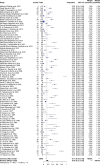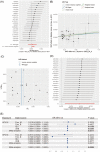The association between human papillomavirus and bladder cancer: Evidence from meta-analysis and two-sample mendelian randomization
- PMID: 36226344
- PMCID: PMC10092419
- DOI: 10.1002/jmv.28208
The association between human papillomavirus and bladder cancer: Evidence from meta-analysis and two-sample mendelian randomization
Abstract
Introduction: Bladder cancer (BCa) is the 10th most common type of cancer worldwide, and human papillomavirus (HPV) is the most common sexually transmitted infection. However, the relationship between HPV infection and the risk of BCa is still controversial and inconclusive.
Methods: This systematic review and meta-analysis were conducted following the PRISMA 2020 reporting guideline. This study searched four bibliographic databases with no language limitation. The databases included PubMed (Medline), EMBASE, Cochrane Library, and Web of Science. Studies evaluating the interaction between HPV infection and the risk of BCa from inception through May 21, 2022, were identified and used in this study. This study estimated the overall and type-specific HPV prevalence and 95% confidence intervals (95% CI) using Random Effects models and Fixed Effects models. In addition, this study also calculated the pooled odds ratio and pooled risk ratio with 95% CI to assess the effect of HPV infection on the risk and prognosis of bladder cancer. Two-sample mendelian randomization (MR) study using genetic variants associated with HPV E7 protein as instrumental variables were also conducted.
Results: This study retrieved 80 articles from the four bibliographic databases. Of the total, 27 were case-control studies, and 53 were cross-sectional studies. The results showed that the prevalence of HPV was 16% (95% CI: 11%-21%) among the BCa patients, most of which were HPV-16 (5.99% [95% CI: 3.03%-9.69%]) and HPV-18 (3.68% [95% CI: 1.72%-6.16%]) subtypes. However, the study found that the prevalence varied by region, detection method, BCa histological type, and sample source. A significantly increased risk of BCa was shown for the positivity of overall HPV (odds ratio [OR], 3.35 [95% CI: 1.75-6.43]), which was also influenced by study region, detection method, histological type, and sample source. In addition, the study found that HPV infection was significantly associated with the progression of BCa (RR, 1.73 [95% CI: 1.39-2.15]). The two-sample MR analysis found that both HPV 16 and 18 E7 protein exposure increased the risk of BCa (HPV 16 E7 protein: IVW OR per unit increase in protein level = 1.0004 [95% CI: 1.0002-1.0006]; p = 0.0011; HPV 18 E7 protein: IVW OR per unit increase in protein level = 1.0003 [95% CI: 1.0001-1.0005]; p = 0.0089).
Conclusion: In conclusion, HPV may play a role in bladder carcinogenesis and contribute to a worse prognosis for patients with BCa. Therefore, it is necessary for people, especially men, to get vaccinated for HPV vaccination to prevent bladder cancer.
Keywords: HPV prevalence; bladder cancer; human papillomavirus; mendelian randomization; meta-analysis.
© 2022 The Authors. Journal of Medical Virology published by Wiley Periodicals LLC.
Conflict of interest statement
The authors declare no conflict of interest.
Figures









References
-
- Siegel RL, Miller KD, Jemal A. Cancer statistics, 2020. CA Cancer J Clin. 2020;70(1):7‐30. - PubMed
-
- Babjuk M, Burger M, Compérat EM, et al. European association of urology guidelines on non‐muscle‐invasive bladder cancer (TaT1 and carcinoma in situ)—2019 update. Eur Urol. 2019;76(5):639‐657. - PubMed
-
- Jørgensen KR, Jensen JB. Human papillomavirus and urinary bladder cancer revisited. APMIS. 2020;128(2):72‐79. - PubMed
-
- Gamboa‐Loira B, Cebrián ME, Franco‐Marina F, López‐Carrillo L. Arsenic metabolism and cancer risk: a meta‐analysis. Environ Res. 2017;156:551‐558. - PubMed
Publication types
MeSH terms
LinkOut - more resources
Full Text Sources
Medical

